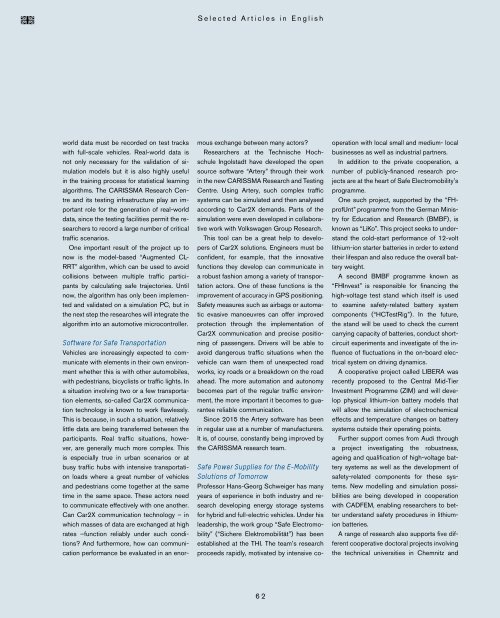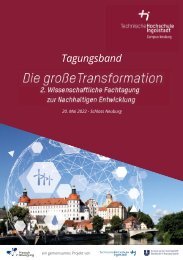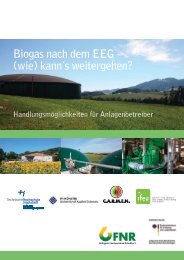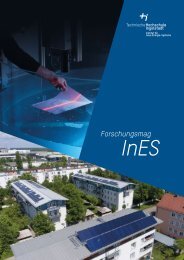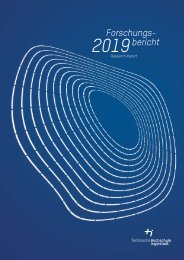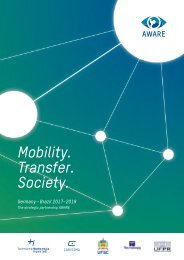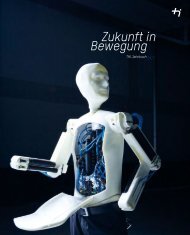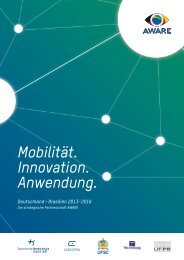thi_motion_Nr4
Erfolgreiche ePaper selbst erstellen
Machen Sie aus Ihren PDF Publikationen ein blätterbares Flipbook mit unserer einzigartigen Google optimierten e-Paper Software.
Selected Articles in English<br />
world data must be recorded on test tracks<br />
with full-scale vehicles. Real-world data is<br />
not only necessary for the validation of simulation<br />
models but it is also highly useful<br />
in the training process for statistical learning<br />
algorithms. The CARISSMA Research Centre<br />
and its testing infrastructure play an important<br />
role for the generation of real-world<br />
data, since the testing facilities permit the researchers<br />
to record a large number of critical<br />
traffic scenarios.<br />
One important result of the project up to<br />
now is the model-based “Augmented CL-<br />
RRT” algorithm, which can be used to avoid<br />
collisions between multiple traffic participants<br />
by calculating safe trajectories. Until<br />
now, the algorithm has only been implemented<br />
and validated on a simulation PC, but in<br />
the next step the researches will integrate the<br />
algorithm into an automotive microcontroller.<br />
Software for Safe Transportation<br />
Vehicles are increasingly expected to communicate<br />
with elements in their own environment<br />
whether <strong>thi</strong>s is with other automobiles,<br />
with pedestrians, bicyclists or traffic lights. In<br />
a situation involving two or a few transportation<br />
elements, so-called Car2X communication<br />
technology is known to work flawlessly.<br />
This is because, in such a situation, relatively<br />
little data are being transferred between the<br />
participants. Real traffic situations, however,<br />
are generally much more complex. This<br />
is especially true in urban scenarios or at<br />
busy traffic hubs with intensive transportation<br />
loads where a great number of vehicles<br />
and pedestrians come together at the same<br />
time in the same space. These actors need<br />
to communicate effectively with one another.<br />
Can Car2X communication technology – in<br />
which masses of data are exchanged at high<br />
rates –function reliably under such conditions?<br />
And furthermore, how can communication<br />
performance be evaluated in an enormous<br />
exchange between many actors?<br />
Researchers at the Technische Hochschule<br />
Ingolstadt have developed the open<br />
source software “Artery” through their work<br />
in the new CARISSMA Research and Testing<br />
Centre. Using Artery, such complex traffic<br />
systems can be simulated and then analysed<br />
according to Car2X demands. Parts of the<br />
simulation were even developed in collaborative<br />
work with Volkswagen Group Research.<br />
This tool can be a great help to developers<br />
of Car2X solutions. Engineers must be<br />
confident, for example, that the innovative<br />
functions they develop can communicate in<br />
a robust fashion among a variety of transportation<br />
actors. One of these functions is the<br />
improvement of accuracy in GPS positioning.<br />
Safety measures such as airbags or automatic<br />
evasive manoeuvres can offer improved<br />
protection through the implementation of<br />
Car2X communication and precise positioning<br />
of passengers. Drivers will be able to<br />
avoid dangerous traffic situations when the<br />
vehicle can warn them of unexpected road<br />
works, icy roads or a breakdown on the road<br />
ahead. The more automation and autonomy<br />
becomes part of the regular traffic environment,<br />
the more important it becomes to guarantee<br />
reliable communication.<br />
Since 2015 the Artery software has been<br />
in regular use at a number of manufacturers.<br />
It is, of course, constantly being improved by<br />
the CARISSMA research team.<br />
Safe Power Supplies for the E-Mobility<br />
Solutions of Tomorrow<br />
Professor Hans-Georg Schweiger has many<br />
years of experience in both industry and research<br />
developing energy storage systems<br />
for hybrid and full-electric vehicles. Under his<br />
leadership, the work group “Safe Electromobility”<br />
(“Sichere Elektromobilität”) has been<br />
established at the THI. The team’s research<br />
proceeds rapidly, motivated by intensive cooperation<br />
with local small and medium- local<br />
businesses as well as industrial partners.<br />
In addition to the private cooperation, a<br />
number of publicly-financed research projects<br />
are at the heart of Safe Electromobility’s<br />
programme.<br />
One such project, supported by the “FHprofUnt”<br />
programme from the German Ministry<br />
for Education and Research (BMBF), is<br />
known as “LiKo”. This project seeks to understand<br />
the cold-start performance of 12-volt<br />
li<strong>thi</strong>um-ion starter batteries in order to extend<br />
their lifespan and also reduce the overall battery<br />
weight.<br />
A second BMBF programme known as<br />
“FHInvest” is responsible for financing the<br />
high-voltage test stand which itself is used<br />
to examine safety-related battery system<br />
components (“HCTestRig”). In the future,<br />
the stand will be used to check the current<br />
carrying capacity of batteries, conduct shortcircuit<br />
experiments and investigate of the influence<br />
of fluctuations in the on-board electrical<br />
system on driving dynamics.<br />
A cooperative project called LIBERA was<br />
recently proposed to the Central Mid-Tier<br />
Investment Programme (ZIM) and will develop<br />
physical li<strong>thi</strong>um-ion battery models that<br />
will allow the simulation of electrochemical<br />
effects and temperature changes on battery<br />
systems outside their operating points.<br />
Further support comes from Audi through<br />
a project investigating the robustness,<br />
ageing and qualification of high-voltage battery<br />
systems as well as the development of<br />
safety-related components for these systems.<br />
New modelling and simulation possibilities<br />
are being developed in cooperation<br />
with CADFEM, enabling researchers to better<br />
understand safety procedures in li<strong>thi</strong>umion<br />
batteries.<br />
A range of research also supports five different<br />
cooperative doctoral projects involving<br />
the technical universities in Chemnitz and<br />
62


